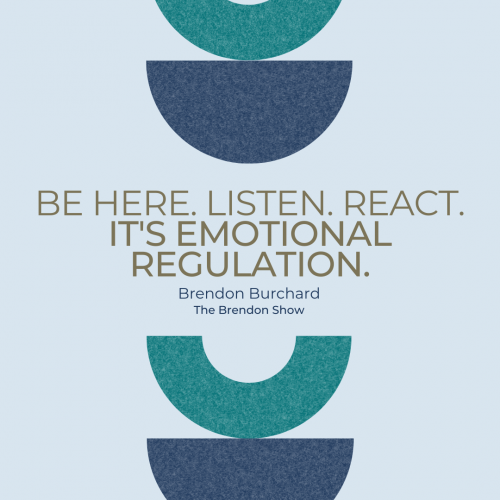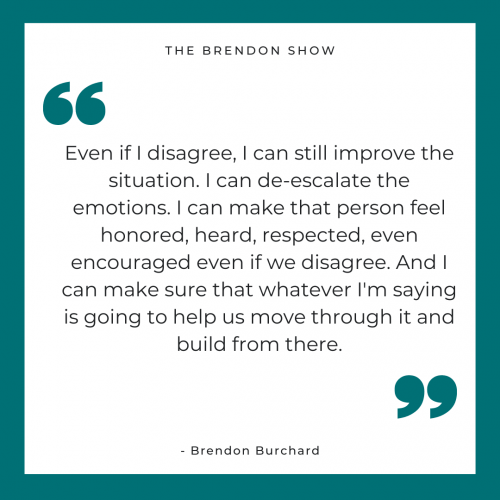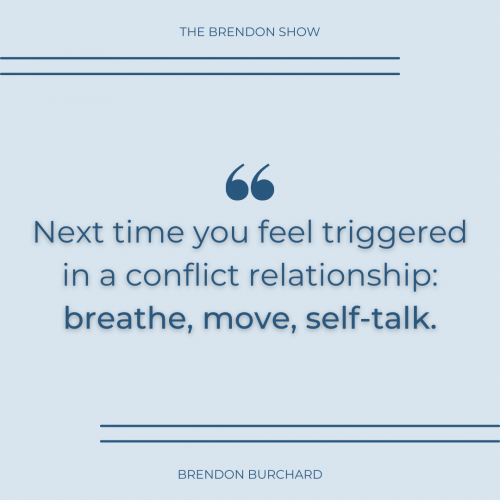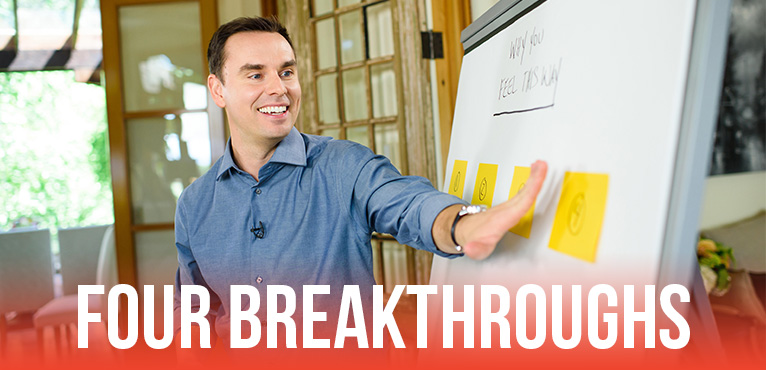SUMMARY
- “Emotional regulation, however, is a conscious choice to sense and feel the emotions coming up and to regulate them appropriately for my intentions or the situation. It means you take the reins of your emotions and your feelings and your behaviors. It means you’re personally responsible for it.”
- In a conflict situation, you have a choice between emotional contagion or emotional regulation. In this episode, learn why when you choose emotional regulation, you choose to control, understand, and improve the relationship.
- “Next time you feel triggered in a conflict-relationship, breathe, move, self-talk, that’s your three emotional regulation moves.”
- Don’t abruptly react when in conflict. Instead, take a quick break to take deep breaths, physically move around, and talk to yourself. In this episode, learn which emotions to focus on and how to get back into a neutral or positive state.
- Watch the video to get the full training.
- Already have the High Performance Planner and CRUSHING each and every day? Let’s celebrate you! Take a photo with your planner and use #GrowthDay so we can find you on social media!
HOT NEWS & DEALS!
-
Get the Confidence Masterclass
Stop letting limiting beliefs and lack of confidence hold you back! Learn the SKILLS of confidence from 9 of the world’s best personal development experts in the most comprehensive Confidence training ever created! $400 worth of training – just $7.99 today! Get the Confidence Masterclass!
-
Get the GrowthDay app!
Make self-improvement a way of life and get the GrowthDay app! GrowthDay features all your personal development tools, coaching and community in one place. Write your journal, track your habits, take wellness challenges, watch live influencers teaching new life strategies, and join a global community of positive and supportive high achievers excited to improve their lives! Get the app on Apple app store here. Get on Android here. Get desktop here.
DID YOU KNOW?
I give weekly prizes, gratitude and shout-outs to our students, so post a screenshot or video on Instagram and use #TheBrendonShow! I can’t wait to hear your thoughts about this episode!
RELATED POSTS
The 4 Steps To Better Health
Optimize Your Health And Productivity
Tips for Developing Close Relationships
The Friendship Masterclass
Nurturing Great Relationships



FULL TRANSCRIPT
[The following is the full transcript of this episode of The Brendon Show. Please note that this episode, like all TBS episodes, features Brendon speaking extemporaneously–he is unscripted and unedited. Filmed in one take, The Brendon Show has become one of the most viewed unscripted, direct-to-camera self-help series in the history of YouTube. It has also been the #1 Podcast in all of iTunes and is regularly in the top podcasts in the Self-Help and Health categories around the globe. Subscribe to the free motivational podcast on iTunes or Stitcher.)
1. Take Responsibility For Your Emotions
Practice emotional regulation. Practice emotional regulation. And we’re going to talk about what that means because here’s what happens: You have two choices in a conflict situation. You have emotional regulation or you have emotional contagion. You’d better make that choice consciously. Emotional regulation or emotional contagion. So, what is emotional contagion?
Emotional contagion is that part of us that we are hardwired to do, which is mimic or act out, response to someone else’s emotions. It’s how when you walk up to a group of three people who are sad, you start to feel sad.
It’s how an eight-month-year-old baby Mel Abraham will when you smile at the eight month-year-old and you and they smile back. They can’t help it. What’s happening there? It’s in your brain and your prefrontal cortex. These things are called the mirror neurons that make you, or in your cortex, help you want to mimic other people and match their emotions. It’s why when someone yawns, you yawn. It’s why when someone gets super angry, you feel your blood go up. It’s automatic. It’s impulsive. And it is hard-wired until we run a new program over so many times that that gets dampened and maybe it doesn’t go away, but it gets dampened. Right?
Emotional regulation, however, is a conscious choice to sense and feel the emotions coming up and to regulate them appropriately for my intentions or the situation. It means you take the reins of your emotions and your feelings and your behaviors.
It means you’re personally responsible for it. And that’s hard because if you heard me teach on this before, there’s a big difference between emotions and feelings. I talked about it in the Daily Fire that your emotions psychologically – so when we talk about emotions in my field of practice, whether it is in what actually doesn’t matter what field of practice, if it’s in psychology if it’s in coaching work, emotions are automatic, physical, impulsive and very difficult to dictate. Their extremity. Just like emotions tend to happen. Feelings, however, I think feelings are kind of like the wake of emotion, but you get to apply meaning to it. Feelings you have much more control over it. It’s the lingering effect of emotion. Emotion and most, at least, neuroscience and most studies of the physiology of emotion and emotion are actually pretty quick to come up and go, right? Emotion can come in maybe 60 seconds, 90 seconds, or sometimes two or three minutes in the extreme. But the emotion itself tends to pass. And now the brain is starting to label it, attach meaning to it, and decide what does this mean? What does this mean for me? Is this safe? Is this bad? A lot of mental processing is actually taken over, and now it’s creating a lasting feeling.
2. Remain Objective During Conflicts
Your spouse comes home and they start accusing you of a bunch of random stuff. How do you meet that? Well, hopefully, you go, OK, this person must have been traumatized or triggered at work today. This is a person who is, you know, creating a situation – that could get not good, so I want to improve the situation and I want to build a relationship. This is my spouse. This is my partner. I’ve committed and sworn to God that I will honor and protect and love and serve and care for and be there with and for this person. OK, I take another deep breath. Let me not react. Let me start – manage my self-talk immediately. Be here. Take deep breaths. Listen, Brendon.
Be here. Take deep breaths. Listen, Brendon. It’s not reacting. It’s not screaming. It’s just here. Listen. React. It’s emotional regulation.
3. Let the Other Person Talk
My friend, John Gray, wrote this book called Men Are From Mars, Women Are From Venus. And whether or not you like that metaphor or whether that’s old school now in the modern era, one of the things he said to me one time was so good. He said, I was talking about, he was asking me about conflicts I had in my relationship and how I approached them, what I said to myself, and everything else. And he goes – he literally interrupts me, describing what I think is my coping mechanism and he goes, Brendon, do you wear a watch? Yeah, I wear a watch. He goes, here’s what I want you to do: Next time your partner is saying something that you don’t like or they’re venting to you and you don’t want to hear it, and it’s going to cause you to get angry or mad or to solve or to react. Next time, all I want you to do is, as they’re talking, make great eye contact. Take a lot of deep breaths. Really quickly glance at your watch. Don’t let them see it. And just wait 20 minutes as you make eye contact and you breathe. I said, 20 minutes. Why?
He goes because by the end of 20 minutes, they’re out of gas. They vented, they were frustrated, they got it out, and you were there: Listening, being attentive, not solving her problem, not telling her she’s wrong. You just let her go for 20 minutes, man. I go, that’s it? He goes, you got a watch? Oh, my gosh. And you know what? It’s real. It totally works. For the guys looking for the tactic, shut up. Listen. Give her some time to talk. This works in almost every relationship, every conflict situation.
4. Excuse Yourself if You Need a Moment
The other person really needs to vent and talk it out. And if you can understand, they’re coming from a place where they are triggered or traumatized, where they’re being defensive. Did you know the more people tend to talk and if a person just sits there with them, the more they talk it out, the more they actually calm themselves down? Right? Therapists will know this, right? You just sit and listen sometimes. Right? Very rarely with another person who’s holding a good space there will someone keep ramping it up. You got to practice emotional regulation. Soon as you feel it come up, breathe. Maybe move around a little bit. Go for a walk or pause the conversation. Go, you know what, I’m feeling really upset or triggered right now, can I take a beat? Can I just – I’m going to do a lap around the house. I’ll be right back. Is that OK? Can we just hold it for a second? I really want to do a good job for you in this conversation. I hear this is important for you, but I’m all kind of frazzled. Can I come right back and be more centered with you? Oh, we’re allowed to say that? Yeah, OK. You go around and take a deep breath. Now you come back centered, calmer. You breathe, you moved, and remember the self-talk.
Remember, the self-talk.
Self-talk is what generates the feeling after the emotion passes.
So, what are we saying to ourselves? What are we stating? What are the thoughts going through our heads? Being thoughtful about that. Mind again, I already told you, to improve the situation, and build the relationship. Improve the situation, and build the relationship. Even if I disagree,
I can still improve the situation. I can de-escalate the emotions. I can make that person feel honored, heard, respected, and even encouraged even if we disagree. And I can make sure that whatever I’m saying is going to help us move through it and build from there versus attack and destroy.
For those who have that, if you know this, please write it down. I’ve been a person who attacks and destroys. Because being a person who attacks and destroys, you can see the littered dead bodies of old relationships that you hurt. Like you got to go, OK, I’m going, to be honest. I was trained to attack and destroy like a dog but dogs can be trained. Old dogs can learn new tricks. Forgive the language here, but I think it’s really important to be severe about it a little bit and use metaphors like that because most of us, if we are out to attack and destroy someone in an argument, we grew up around it, we saw it. And I’m not judging it, even though it sounds like I am because I’m teaching, I’m raising my hand. That’s what I grew up around. That’s the way I was till my early twenties. Right? So I’m not preaching. Why I’m here is trying to teach what we know from research and from all these years of practice that just helps the situation.
5. Breathe, Move, Self-Talk
So next time you feel triggered in a conflicted relationship, breathe, move, and self-talk, that is your three emotional regulation moves, right? Breathe, move, self-talk. Breathe, move, self-talk. If you like, but I can’t move. I’m kind of I’m stuck there in the situation. They won’t let me leave. They don’t like that. Be like, OK, keep breathing, keep breathing, manage your self-talk, right? Manage your self-talk.
Often, movement can be as simple as maybe taking one step back to feel a little safer. Maybe go on the other side of the kitchen counter. Really? Maybe in the meeting, if you’re feeling that way, move chairs, stand up, and ask: Can we have a conversation? Can we walk and have this conversation? A lot of times I’ll teach managers, take the team or the employee for a walk if you’re there in person. I know it’s hard in a virtual world, but it’s like, it’s much easier to process. Who’s gone on a walk with a friend recently and just found yourself sharing things and feeling better afterward? That’s generating your mood. You’re breathing, you’re moving, you’re having a positive conversation. That can be used here, OK? That can be used here. Again, this is hard. If you’re right there and they’re in your face, I get it. But if they’re right there and they are in your face, you can still breathe and you can still speak to yourself.
You can always breathe and you can always speak to yourself.
You can always breathe, always speak to yourself. Please do that in that situation.


